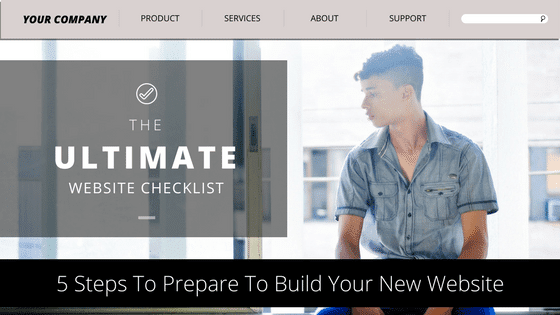A Small business website is always a pain point for the owner.
They know they need one, but they don’t understand what it’s supposed to do.
Most don’t realize how much their site could be working for them.
They see their website as an online brochure for their small business.
It might attract a call.
Someone might come in.
But there is so much more your site could be doing for you.
Contents
Your Small Business Website Is Not A Brochure
Your website exists to do more than giving basic information to your target market.
Despite that, many small business websites lack the capacity to do anything else.
While they’re greatly informative, they’re hardly worth the investment if that’s all they do.
But if your site was earning you leads and sales it might be more valuable.
It would certainly make the expense easier to bear.
With the right features and planning, your website could be doing so much more than it is.
Put Your Small Business’ Website To Work
It’s time to start getting the value from your site that you ought to.
With a few key changes, you can start earning leads and sales from your site.
Even when you’re asleep.
That’s because a website is always on.
It works in the hours you can’t.
If you have everything you need in place, it should help you grow your business much faster.
Here’s what you need to do to make your small business website start working for you.
Improve The Way Your Website Looks
What’s your impression of a company whose website looks like it was built in 2005?
Usually not very good.
There’s something about the way a website looks that plays into our opinion of the business it represents.
The more modern and professional your website is, the better the impression it gives.
It can also get people to stay on your site longer.
As it turns out, people are more likely to stay on a site that they find appealing.
And that’s the goal.
But what about your website?
It’s time to assess how modern and appealing your website is.
It’s got to be something clean and crisp.
The information has to be easy to read with navigation and layout that are simple to understand.
Fixing your site won’t going to take a huge budget either.
You should definitely shell out the extra to hire the best web developer you can.
However, if a web developer is out of your budget, it’s something you can handle yourself.
There are tons of DIY platforms available that make it simple to set up a basic website.
Great as a short-term solution, a DIY website can get you on the web and get your presence known.
Or, as an alternative, you can build your site with WordPress, giving you the option of thousands of free layouts (called themes) to choose from.
These free options aren’t the best choice for the long term, as they usually equate to a look and feel that blends your brand into your competition.
But they’re a great way to improve the way your site looks in the meantime.
That’s going to help you build your traffic and reduce your bounce rate.
Which means you’re going to get found more often in search.
Make It Easier For Site Visitors To Contact You
If people visit your website, they’re usually interested in something about what you do.
They want more information about it.
Sometimes they can find what they’re looking for in your content.
Maybe the answer is in your blog or FAQ.
However, what happens when they don’t find the answer they want as fast as they want to?
Normally they want to contact someone.
So why would you make that hard to do?
Yes, I’m certain your audience is smart enough to know how to find your phone number.
A phone call could most certainly be placed.
However, millennials aren’t inclined to that.
Instead, they’d rather send a text, chat message, or email.
And, if they wait too long for a response, they’re gone.
The last thing you want to do is put barriers in place when it comes to communication.
In most cases, a simple email form is enough.
There, next to your address and phone number, offer a basic form that allows your audience to ask questions.
If you want to take it to the next level, add a live chat option to your site.
A live chat feature allows you to answer your audience’s questions right away.
When there isn’t anyone available to answer, a chatbot can be substituted in to help with the basics.
With a little bit of automation, you can even subvert a few common objections.
Plus, most people are more likely to use live chat than they are an email form.
And, because it’s common to ask for an email address, you can convert them more reliably.
Remember that great communication is only part of the equation.
They need to give you a way to stay in contact with them.
Share What Other Clients Have To Say
There’s something comforting about learning from another person’s experience.
Knowing that the company you’re about to work with has done well in the past puts your mind at ease.
That’s why so many review sites exist.
But you can’t rely on review sites alone.
You need to offer client testimonials on your site.
Client testimonials do a great job of selling your brand in a way you can’t.
People expect you to tell them how awesome your brand is.
Almost to the point of tuning it out.
That makes selling a difficult thing for you, especially through your website.
Past clients, however, have no vested interest in saying something great about your brand.
This truth lends their words, and subsequently your brand, a ton of credibility.
Testimonials also help people understand they’re making the right choice.
When others make the same choice your visitor is considering, it reinforces the idea that it’s the choice they should be making.
They’re more likely to work with you.
In a way, referrals act like word-of-mouth directed at your site visitors.
Contact your clients and ask them for a testimonial.
Usually, that’s all it takes.
Once they’ve responded, add their kind words to your site.
It’s helpful if you can also demonstrate who the client is and what you did for them.
As an example, if you’re a B2B company, you can link to your client’s website, evidence of them using your product or service, and the LinkedIn profile of the person who offered the testimonial.
By demonstrating to your site visitors that this is a real client, you boost the testimonial’s credibility.
The statements carry more weight.
Those statements are going to help you convert more visitors to leads.
Start Your Blog Already
It’s unbelievable how many small business owners still discredit the value of a blog on their website.
There is – hands down – no content tool more effective for drawing visitors to your website than a blog.
Yet, for some reason, it’s still a surprise when I tell people that they need one if they want to attract more leads.
Blogs are, in fact, incredible at drawing in new visitors to your website and instrumental in converting them to leads.
Daily blogging can increase your traffic by up to 500%.
And, just by blogging, you can earn 126% more leads.
If that’s not enough to change your mind, I don’t know if you’re paying attention.
Blogging is critical to making your small business website work for you.
This content medium is responsible for building your credibility, nurturing your leads towards the purchase, and developing your search rank.
Without one, you may as well not even have a website.
With that in mind, it’s time to start yours.
Set up a blog section on your website.
If you’ve built it correctly (or had a professional build it for you) the ability to blog should be built-in.
If it’s not, I refer you back to the first tip.
Start writing blog articles.
You want to get 4-6 together at a minimum before you publish your first one.
That allows you to stay ahead of the curve in the event you get behind.
Begin publishing to your blog at regular intervals.
At least one new article per week.
That’s going to guarantee that you see some of the benefits of having it.
Any less will yield no results.
Stay consistent and produce quality content.
When you do that, you’ll start to see the numbers increase.
Tell Your Visitors What You Want Them To Do
Ever visited a website that you weren’t sure where to go next?
It’s a frustrating feeling, but it happens on a lot of websites.
Many times, there is no clear direction on the site.
Other times there are too many directions.
When your site visitors don’t know what you want them to do on the page they’ve landed on, they likely won’t do it.
That’s where a clear call-to-action comes in.
Calls-to-action exist to direct your audience where to go next.
They let visitors know what you want them to do.
Often taking shape as a simple button, calls-to-action are chatbot what the name implies.
They state the next step, the benefits of it, and offer the ability to take it.
In other cases, the call-to-action is a form to fill out, offering something to the visitor in exchange for only their contact information.
Depending on the purpose of the page your visitor is landing on, the call-to-action you select might be an opportunity to earn a lead or a chance to make a sale.
Whichever you choose, it needs to fit rationally with the purpose of the visit.
For blog pages, the most appropriate choice might be to offer more information with a call-to-action that takes the reader to a lead magnet.
On a landing page or your home page, on the other hand, your call to action should be the first step to becoming a client.
Possibly requesting a quote or asking them to sign up for service.
No matter the call-to-action you use, the most important thing is that you only have one choice per page.
Two choices if they are essentially the same thing.
That’s going to eliminate decision anxiety and improve your odds of converting your visitors.
Your Small Business Website Needs To Work
Bottom line; your website needs to earn you more.
More leads, more sales, and more revenue.
That’s what’s ultimately going to make it worth the time, effort, and money you’ve invested into it.
By taking advantage of the advice I’ve shared, you can start seeing the results of a working site.
It’s not hard.
But it takes careful thought and strategy.
You need to know what you want from the visitors you get.
As long as you understand that, you’re going to build quickly through your small business website.





